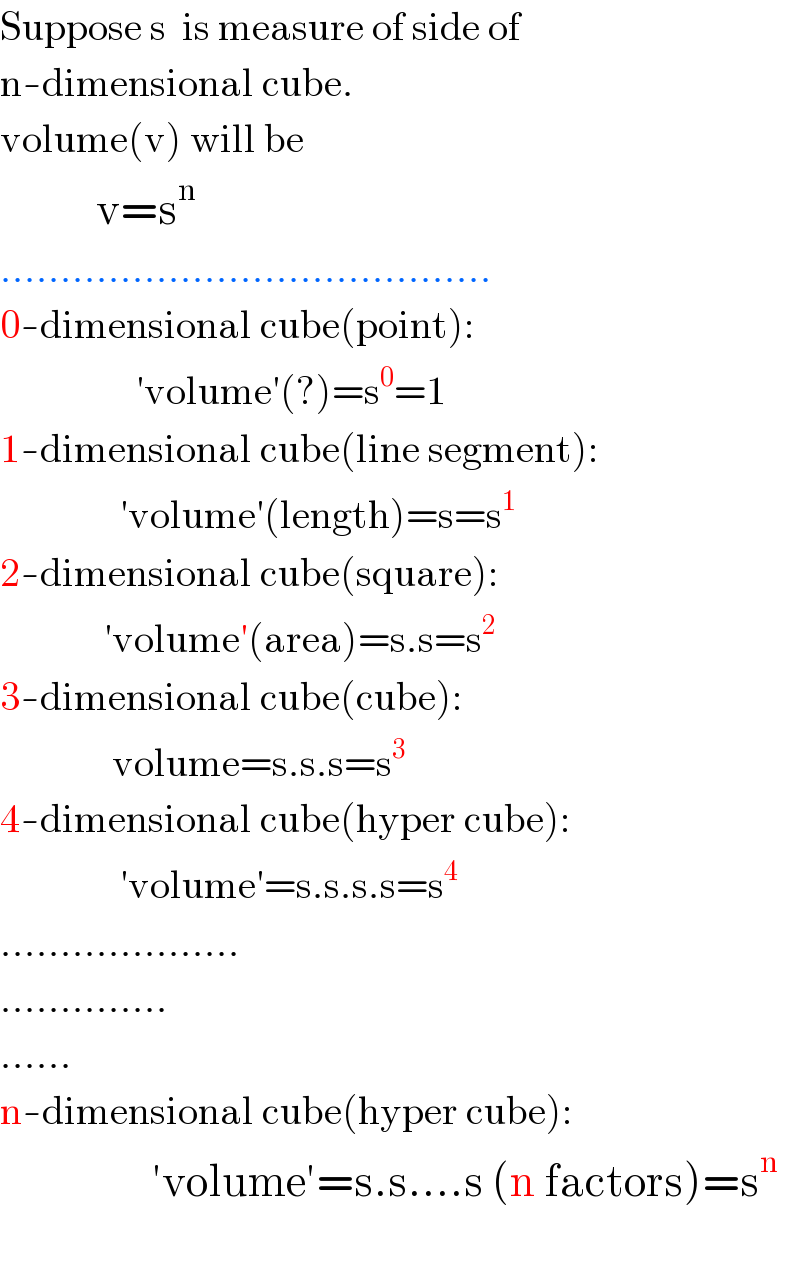
Question Number 5398 by FilupSmith last updated on 13/May/16

$$\mathrm{If}\:\mathrm{we}\:\mathrm{have}\:\mathrm{an}\:{n}−\mathrm{dimensional}\:\mathrm{cube}. \\ $$$$\mathrm{How}\:\mathrm{do}\:\mathrm{we}\:\mathrm{find}\:\mathrm{its}\:'{volume}'? \\ $$
Commented by Rasheed Soomro last updated on 13/May/16

$$\mathrm{Suppose}\:\mathrm{s}\:\:\mathrm{is}\:\mathrm{measure}\:\mathrm{of}\:\mathrm{side}\:\mathrm{of}\: \\ $$$$\mathrm{n}-\mathrm{dimensional}\:\mathrm{cube}. \\ $$$$\mathrm{volume}\left(\mathrm{v}\right)\:\mathrm{will}\:\mathrm{be} \\ $$$$\:\:\:\:\:\:\:\:\:\:\:\:\mathrm{v}=\mathrm{s}^{\mathrm{n}} \\ $$$$......................................... \\ $$$$\mathrm{0}-\mathrm{dimensional}\:\mathrm{cube}\left(\mathrm{point}\right): \\ $$$$\:\:\:\:\:\:\:\:\:\:\:\:\:\:\:\:\:'\mathrm{volume}'\left(?\right)=\mathrm{s}^{\mathrm{0}} =\mathrm{1} \\ $$$$\mathrm{1}-\mathrm{dimensional}\:\mathrm{cube}\left(\mathrm{line}\:\mathrm{segment}\right): \\ $$$$\:\:\:\:\:\:\:\:\:\:\:\:\:\:\:'\mathrm{volume}'\left(\mathrm{length}\right)=\mathrm{s}=\mathrm{s}^{\mathrm{1}} \\ $$$$\mathrm{2}-\mathrm{dimensional}\:\mathrm{cube}\left(\mathrm{square}\right): \\ $$$$\:\:\:\:\:\:\:\:\:\:\:\:\:'\mathrm{volume}'\left(\mathrm{area}\right)=\mathrm{s}.\mathrm{s}=\mathrm{s}^{\mathrm{2}} \\ $$$$\mathrm{3}-\mathrm{dimensional}\:\mathrm{cube}\left(\mathrm{cube}\right): \\ $$$$\:\:\:\:\:\:\:\:\:\:\:\:\:\:\mathrm{volume}=\mathrm{s}.\mathrm{s}.\mathrm{s}=\mathrm{s}^{\mathrm{3}} \\ $$$$\mathrm{4}-\mathrm{dimensional}\:\mathrm{cube}\left(\mathrm{hyper}\:\mathrm{cube}\right): \\ $$$$\:\:\:\:\:\:\:\:\:\:\:\:\:\:\:'\mathrm{volume}'=\mathrm{s}.\mathrm{s}.\mathrm{s}.\mathrm{s}=\mathrm{s}^{\mathrm{4}} \\ $$$$.................... \\ $$$$.............. \\ $$$$...... \\ $$$$\mathrm{n}-\mathrm{dimensional}\:\mathrm{cube}\left(\mathrm{hyper}\:\mathrm{cube}\right): \\ $$$$\:\:\:\:\:\:\:\:\:\:\:\:\:\:\:\:\:\:\:'\mathrm{volume}'=\mathrm{s}.\mathrm{s}....\mathrm{s}\:\left(\mathrm{n}\:\mathrm{factors}\right)=\mathrm{s}^{\mathrm{n}} \\ $$$$ \\ $$
Commented by Rasheed Soomro last updated on 13/May/16

$$\mathrm{Can}\:\mathrm{we}\:\mathrm{think}\:\mathrm{of}\:\:−\mathrm{1}-\mathrm{dimensional}\:\mathrm{cube} \\ $$$$\:\:\:\:\:\:\:\:\:\:\:\:\:\:\:\:\:\:\:\:'\mathrm{volume}'=\mathrm{s}^{−\mathrm{1}} =\frac{\mathrm{1}}{\mathrm{s}} \\ $$$$\:\:\:\:\:\:\mathrm{And}\:\mathrm{so}\:\mathrm{on}.\:\:\:\:\:\:\: \\ $$
Commented by prakash jain last updated on 13/May/16

$$\mathrm{There}\:\mathrm{was}\:\mathrm{an}\:\mathrm{earlier}\:\mathrm{question}\:\mathrm{about}\:\mathrm{surface} \\ $$$$\mathrm{area}\:\mathrm{and}\:\mathrm{valume}\:\mathrm{of}\:{n}−\mathrm{sphere}. \\ $$
Commented by Yozzii last updated on 14/May/16

$${What}\:{about}\:{other}\:{figures}\:{in}\:{dimensions} \\ $$$${higher}\:{than}\:\mathrm{3},\:{like}\:{cuboids},\:{spheres}, \\ $$$${cylinders},{torus},\:{frustrum},\:{etc}.\:? \\ $$$${Is}\:{there}\:{any}\:{general}\:{theorem}\:{with} \\ $$$${regard}\:{to}\:{this}? \\ $$
Commented by Rasheed Soomro last updated on 14/May/16

$$\mathrm{The}\:\mathrm{anologues}\:\mathrm{of}\:\mathrm{the}\:\mathrm{mentioned}\:\mathrm{figures} \\ $$$$\left(\mathrm{in}\:\mathrm{various}\:\mathrm{dimensional}\:\mathrm{spaces}/\mathrm{plane}\right) \\ $$$$\mathrm{should}\:\mathrm{be}\:\mathrm{considered}\:\mathrm{indidually}. \\ $$$$\mathrm{For}\:\mathrm{example}\:\mathrm{cuboid}\:\mathrm{has}\:\:\mathrm{anologues} \\ $$$${point},{line}-{segment},{rectangle},{cuboid}, \\ $$$$...{in}\:\mathrm{0},\mathrm{1},\mathrm{2},\mathrm{3}....{dimensional}\:{spaces}\:{respectively}. \\ $$$$\mathrm{If}\:{l}_{\mathrm{1}} ,{l}_{\mathrm{2}} ,{l}_{\mathrm{3}} ,...,{l}_{{n}\:} {are}\:{dmensional}\:{measures}\:{of} \\ $$$${n}-{dimensional}\:{cuboid},\:{then}\:{volume}\:{will}\:{be} \\ $$$${l}_{\mathrm{1}} {l}_{\mathrm{2}} {l}_{\mathrm{3}} ....{l}_{{n}} .\:{Of}\:{course}\:{anologues}\:{of}\:{some}\:{figures} \\ $$$${and}\:{their}\:{characteristics}\left({volume},{surface}-{area}\right. \\ $$$$\left.{etc}\right){are}\:{somewhat}\:{difficult}\:{to}\:{consider}. \\ $$$$ \\ $$
Commented by Yozzii last updated on 14/May/16

$${Interesting}... \\ $$
